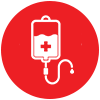Two gene therapies were approved in Dec. 2023 by the Food and Drug Administration (FDA) to treat sickle cell disease: exagamglogene autotemcel and lovotibeglogene autotemcel. These treatments are considered potentially curative.
STEP ONE
Doctors collect stem cells from your body. The blood-forming stem cells make your red blood cells and other blood cells. The DNA in these stem cells create sickled red blood cells. Collecting enough stem cells often needs several sessions.










